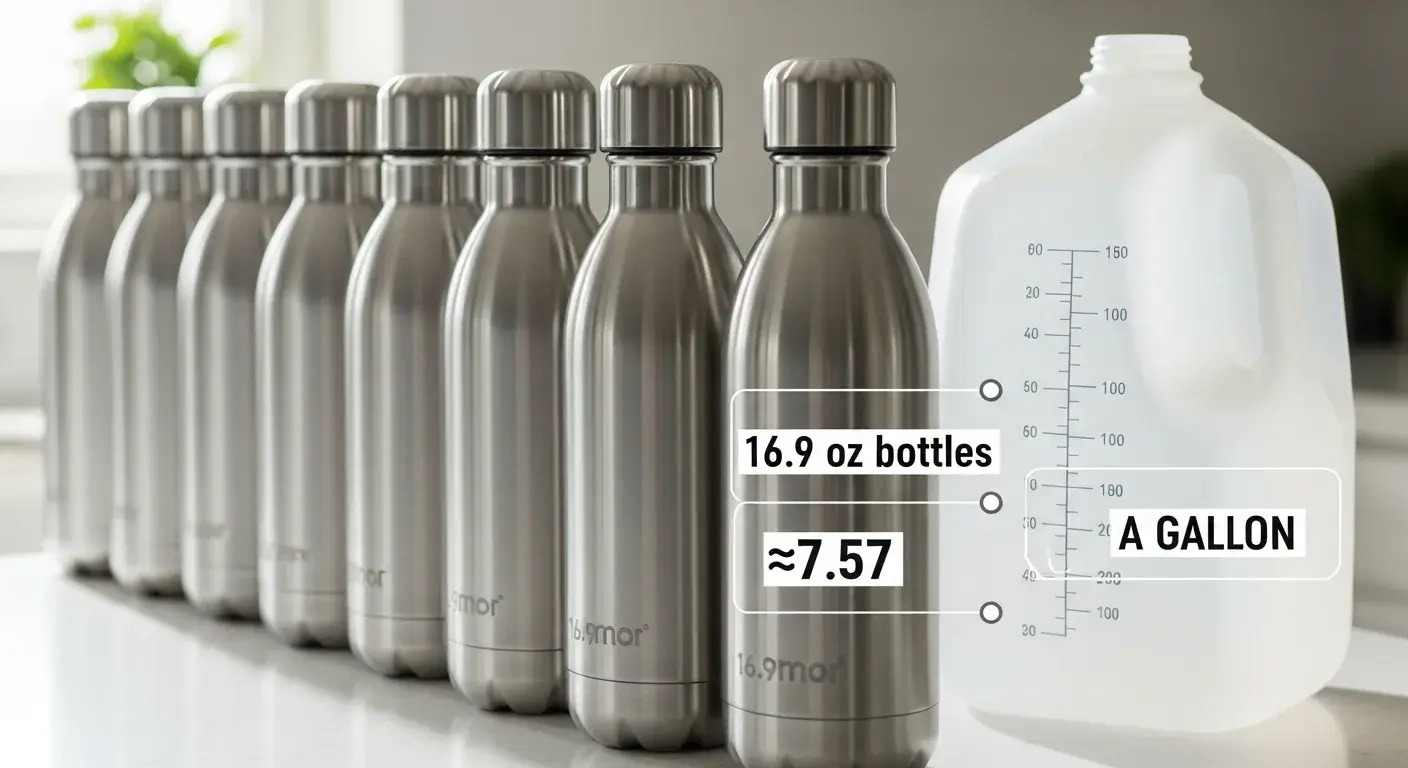
When it comes to hydration, understanding how many bottles make up a gallon can be quite helpful. Whether you're planning an event or tracking your daily water intake, it's important to know the correct conversion.
A U.S. gallon is 128 fluid ounces. A standard water bottle is typically 16.9 ounces. This means that about 7.57 bottles of 16.9 oz water make up a gallon.
Knowing this conversion can make hydration more manageable and help plan water supplies efficiently for various events or activities.
How Many Bottles of Water Make a Gallon?
Knowing how many bottles are in a gallon is essential for several reasons, from hydration tracking to event planning. A U.S. gallon contains 128 fluid ounces. If you use a standard 16.9 oz bottle, you need about 7.57 bottles to make one gallon of water.
In a U.S. gallon, 7.57 bottles of 16.9 oz water are required to make up the full 128 ounces.
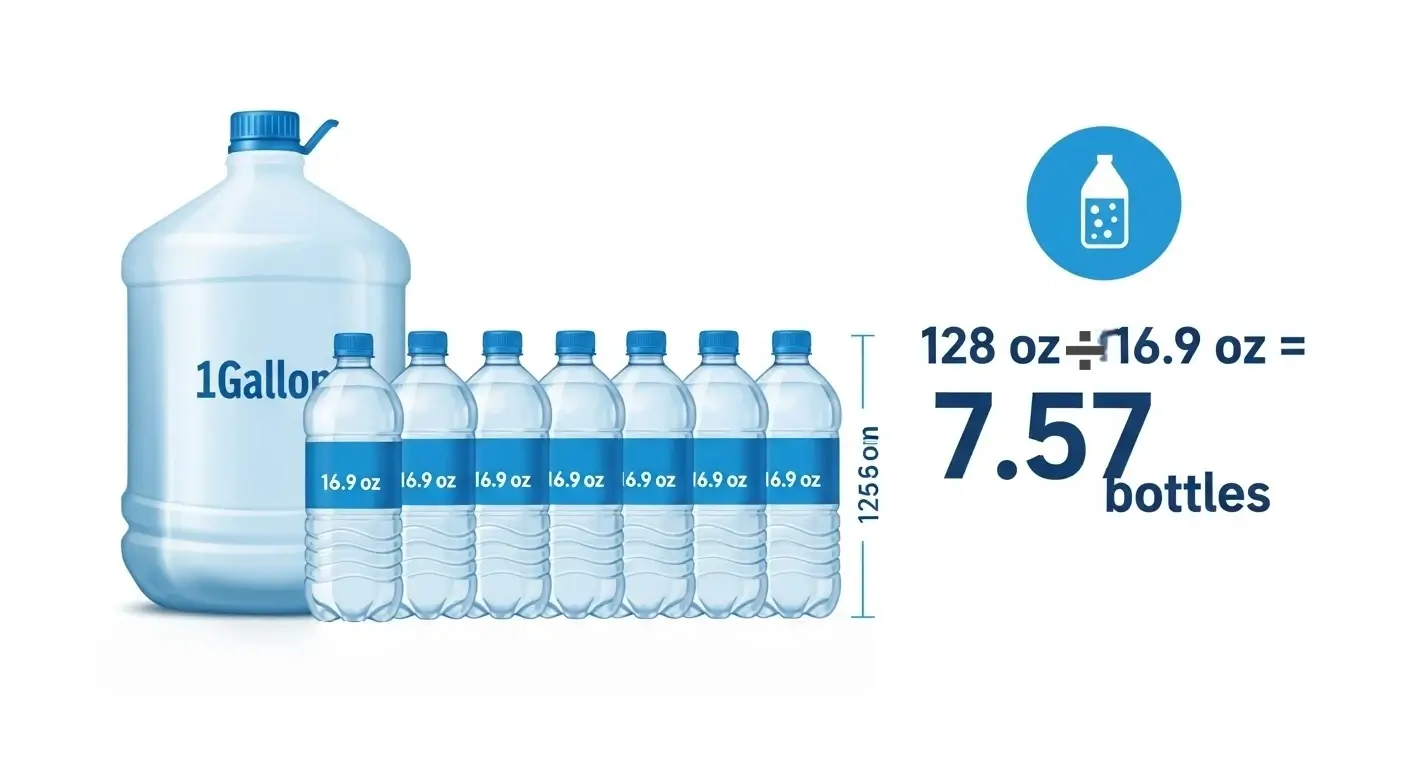
Understanding the math behind this is crucial. For instance, if you’re buying bottled water for a large event or managing inventory, knowing how many bottles make up a gallon can help optimize your planning.
Conversion Table: Bottles to Gallons for Popular Sizes
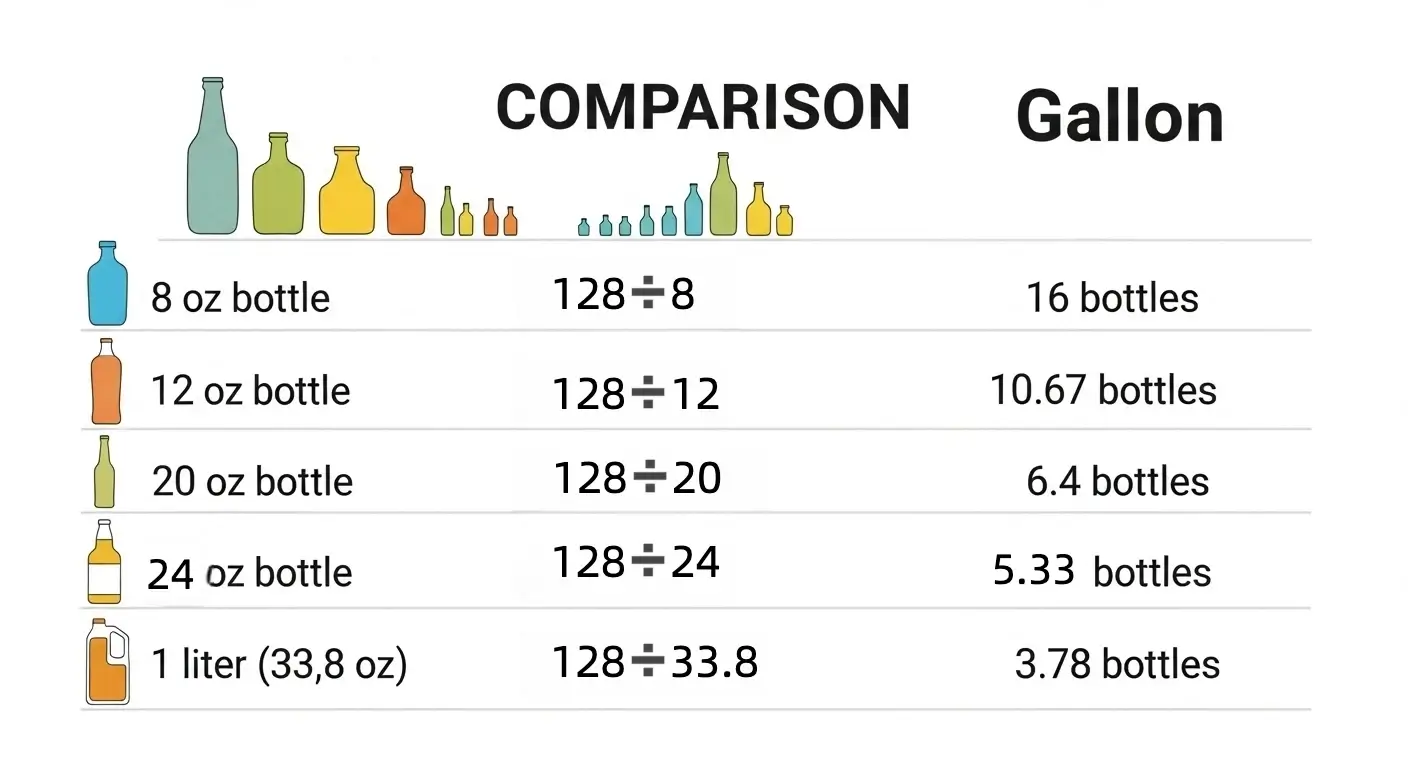
To make it even easier, here's a table showing the number of bottles per gallon for various common bottle sizes:
| Bottle Size (oz) | Bottles per US Gallon (128 oz) | Bottles per UK Gallon (160 oz) |
|---|---|---|
| 8 | 16 | 20 |
| 12 | 10.67 | 13.33 |
| 16.9 | 7.57 | 9.47 |
| 20 | 6.4 | 8 |
| 24 | 5.33 | 6.67 |
| 33.8 (1 liter) | 3.78 | 4.73 |
U.S. Gallon vs. UK Gallon: What’s the Difference?
The U.S. gallon1 and the UK (imperial) gallon2 are different units of measurement. While the U.S. gallon equals 128 fluid ounces, the UK gallon is 160 fluid ounces. This means that you would need more bottles to reach a UK gallon.
For example:
- 1 U.S. gallon = 128 oz
- 1 UK gallon = 160 oz
Why Does Bottle Size Matter?
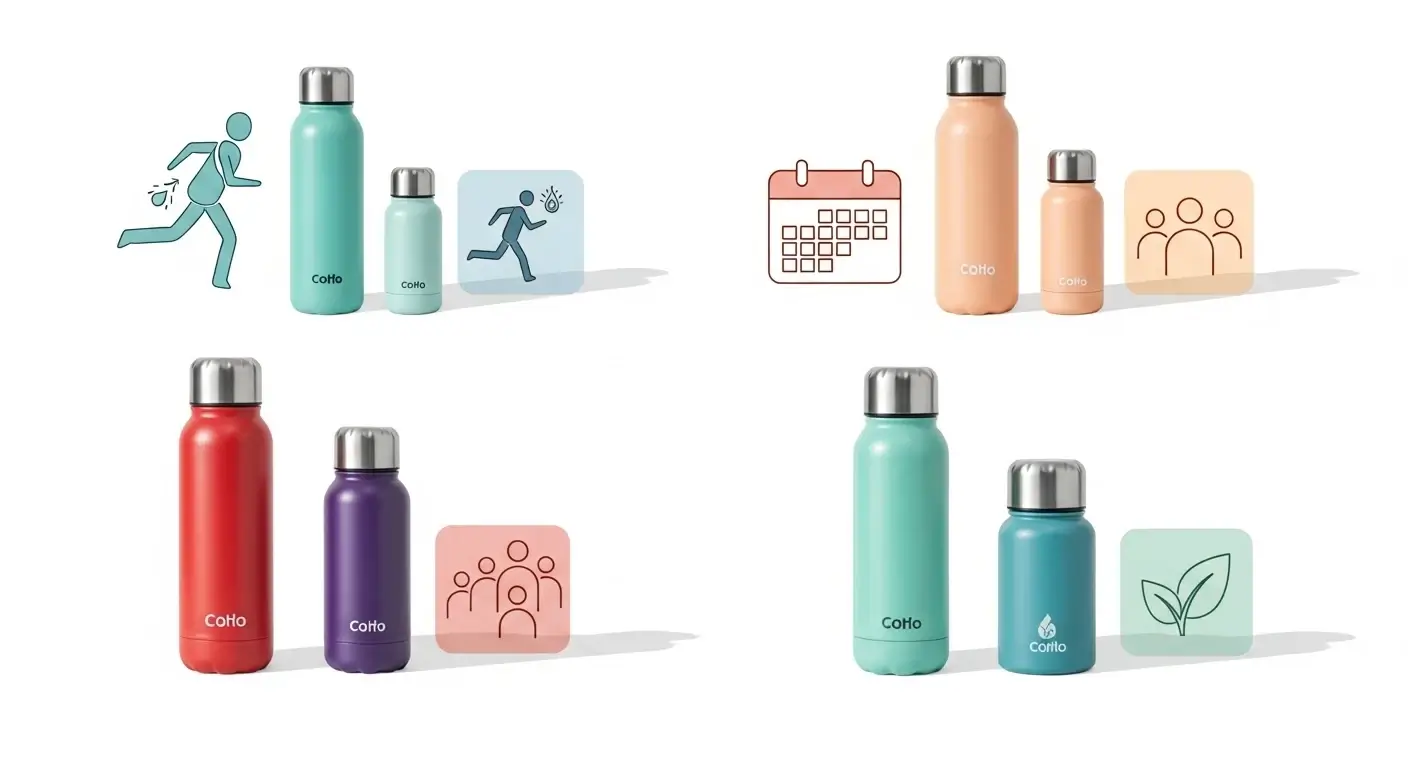
Knowing how many bottles make up a gallon isn’t just about measurements—it’s also about practical applications like hydration, events, and sustainability.
Hydration: For most adults, the goal is to drink around 8-10 bottles of 16.9 oz water per day. This translates to about half your body weight in ounces3. Therefore, understanding bottle sizes and their conversions can help you track your daily hydration needs more accurately.
Event Planning: Whether it’s for a wedding, a conference, or a charity event, understanding how many bottles you need per gallon will help you prepare enough water for guests, avoiding waste and shortages.
Sustainability: Opting for larger water bottles or reusable options4 can help reduce plastic waste. If you’re organizing an event, consider using large water dispensers to cut down on the need for individual plastic bottles.
How to Convert Bottles to a Gallon

Converting bottles to a gallon is simple math. Since a U.S. gallon equals 128 fluid ounces, you can use the following formula to convert any bottle size to the number of bottles per gallon:
Conversion Formula
Number of Bottles = Total Ounces in a Gallon / Bottle Size in Ounces
For example, if you're using a standard 16.9 oz bottle, here's how the math works:
128 oz ÷ 16.9 oz = 7.57 bottles
So, 7.57 bottles of 16.9 oz water equals 1 U.S. gallon.
You can use this formula for any bottle size:
- 8 oz bottle: 128 ÷ 8 = 16 bottles
- 12 oz bottle: 128 ÷ 12 = 10.67 bottles
- 20 oz bottle: 128 ÷ 20 = 6.4 bottles
- 1 liter (33.8 oz): 128 ÷ 33.8 = 3.78 bottles
Quick Reference: Conversion Table
| Bottle Size (oz) | Bottles per US Gallon (128 oz) |
|---|---|
| 8 | 16 |
| 12 | 10.67 |
| 16.9 | 7.57 |
| 20 | 6.4 |
| 24 | 5.33 |
| 33.8 (1 liter) | 3.78 |
U.S. Gallon vs. UK Gallon
If you're converting to a UK gallon, remember that it equals 160 fluid ounces. So, the formula would change slightly:
Number of Bottles (UK) = Total Ounces in UK Gallon / Bottle Size in Ounces
For example:
- 16.9 oz bottle: 160 ÷ 16.9 = 9.47 bottles
You can use the same conversion approach for any bottle size, but always remember to check the correct unit of gallon you're working with.
How Much Water Should You Drink Each Day?
Water is essential for health and wellbeing. But how much should you drink every day? The recommended amount of water varies from person to person, influenced by factors like age, weight, activity level, and climate. The most common advice is to aim for about 8 cups of water a day, which is equivalent to around 8–10 bottles of 16.9 oz water, or roughly 64–80 ounces of water daily.
Generally, most adults need about 8-10 bottles of 16.9 oz water per day for proper hydration, though individual needs may vary based on activity and climate.

Hydration Needs Based on Weight and Activity Level
One of the best ways to estimate how much water you need is based on your body weight. A general rule is to drink half of your body weight in ounces each day. For example:
- If you weigh 150 pounds, aim for around 75 ounces of water daily.
- If you weigh 200 pounds, aim for 100 ounces of water.
People who are more active may need more water to compensate for the fluids lost through sweat. If you’re an athlete, or if you're engaging in strenuous activities like running or lifting weights, you should increase your water intake to stay properly hydrated.
Climate and Environment
Your environment plays a huge role in determining how much water you need. Hot and humid climates make you sweat more, requiring additional water intake. Conversely, in cooler climates, your body might retain more moisture, reducing your water needs. For example:
- During the summer months or in a hot environment, you may need to increase your water intake by an extra bottle or two.
- In colder environments, you may not feel thirsty as much, but you still need to drink enough to stay hydrated.
Signs of Dehydration
If you’re unsure whether you’re drinking enough water, there are some common signs of dehydration to look out for:
- Dark yellow urine: Your urine should be light yellow. Dark urine can be a sign that you're not drinking enough water.
- Dry mouth and skin: If your skin is dry and your mouth feels parched, you might need to hydrate.
- Fatigue and dizziness: Dehydration can lead to low energy levels and dizziness, especially after physical activity.
Special Considerations
- Pregnancy: Pregnant women should drink extra water to stay hydrated. A good rule of thumb is to add about 10 extra ounces per day.
- Breastfeeding: Mothers who are breastfeeding need more fluids, as they lose additional water through milk production. Aim for an extra 12 cups of water per day.
Ultimately, the right amount of water depends on your personal needs. Listen to your body, monitor how you feel, and adjust your intake as necessary.
Environmental Impact: Bottled Water vs. Reusable Bottles
The bottled water industry has grown significantly over the years. However, the environmental impact of single-use plastic bottles5 is considerable. Every year, billions of plastic bottles end up in landfills and oceans, contributing to pollution and harming wildlife. If you’re looking for ways to reduce your environmental footprint, switching to reusable bottles6 is one of the most effective actions you can take.
Plastic waste from bottled water contributes to pollution and environmental damage. Switching to reusable bottles is a sustainable solution for reducing waste and promoting health.
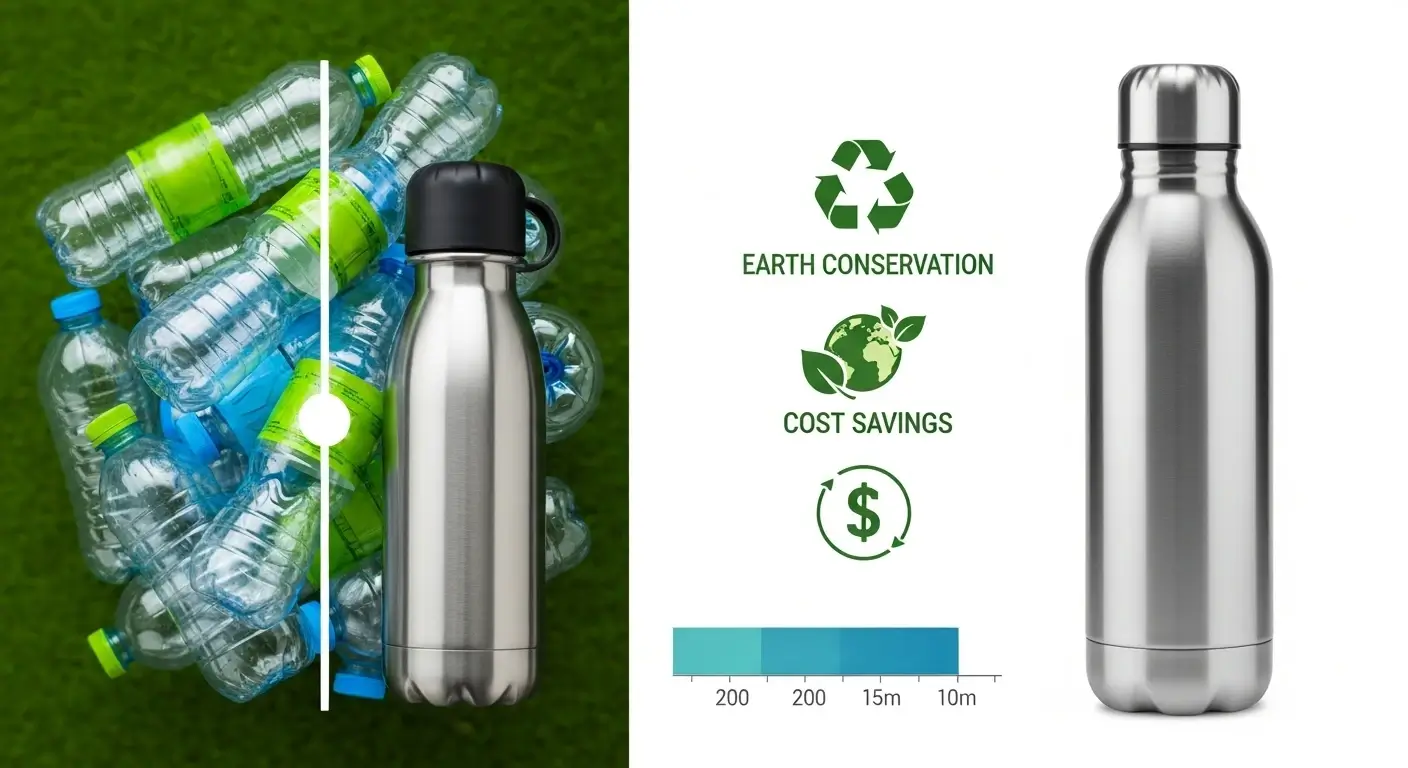
The Plastic Problem
The production and disposal of plastic bottles create substantial environmental harm. Here’s a closer look at the impact:
- Plastic Waste: According to the Environmental Protection Agency (EPA), Americans alone dispose of about 35 billion plastic bottles every year, many of which are not recycled. Instead, they end up in landfills or the ocean.
- Pollution in Oceans: Plastic bottles and their caps are among the most commonly found items during beach clean-ups. These bottles break down into microplastics, which are harmful to marine life and ecosystems.
- Resource Waste: Producing plastic bottles requires significant resources. It takes about 3 liters of water to produce a single 1-liter plastic bottle, not to mention the energy required for manufacturing and transportation.
The Benefits of Reusable Bottles
Switching to reusable bottles offers many advantages, both for your health and the environment:
- Reduction in Waste: By using a reusable bottle, you help reduce the demand for plastic bottles, which means less plastic waste.
- Cost-Effective: Investing in a durable, high-quality reusable bottle can save you money in the long run since you’ll no longer need to purchase single-use bottled water regularly.
- Better for Your Health: Many reusable water bottles are made from non-toxic materials like stainless steel, which can help avoid harmful chemicals found in some plastic bottles, such as BPA.
- Convenience: Reusable bottles are designed for portability and can be filled up again and again. Many are also designed with insulation to keep your drink cool for longer periods.
Sustainable Alternatives
If you're concerned about the environmental impact of plastic bottles, here are a few sustainable options:
- Stainless Steel Bottles: Made to last, stainless steel bottles are highly durable and often insulated to keep water cold or hot for extended periods. They also do not leach chemicals, making them a safer option.
- Glass Bottles: Glass bottles are another environmentally friendly alternative. They are 100% recyclable and don’t leach chemicals, although they are more fragile than stainless steel.
- BPA-Free Plastic Bottles: If you prefer plastic for its light weight, look for bottles labeled as BPA-free. These bottles don’t contain the harmful chemical Bisphenol A (BPA) commonly found in traditional plastic bottles.
Corporate Sustainability Efforts
Many companies are now focusing on sustainability initiatives by offering branded reusable bottles for events, promotions, and even internal use—offering branded reusable bottles for events7 supports eco-conscious goals and waste reduction. In fact, using reusable bottles in corporate settings not only helps cut down on waste but also aligns with growing consumer demand for eco-conscious brands.
Additionally, events like conferences, festivals, and trade shows are increasingly turning to large water dispensers instead of handing out plastic bottles. This shift toward sustainability benefits both the environment and your brand’s reputation.
Conclusion
Switching to reusable water bottles is a powerful way to reduce plastic waste and lower your environmental impact. Not only does it save you money, but it also promotes a healthier lifestyle by avoiding harmful chemicals found in some plastics. So, the next time you think about reaching for a single-use plastic bottle, consider the long-term impact of your choice and opt for a more sustainable solution instead.
FAQs: Bottles, Gallons, and Daily Water Needs
How many 16.9 oz bottles are in a gallon?
It takes about 7.57 bottles of 16.9 oz water to make a gallon.
How many 8 oz bottles are in a gallon?
There are 16 bottles of 8 oz water in a gallon.
How many liters are in a gallon?
1 U.S. gallon equals approximately 3.785 liters.
Is drinking a gallon of water a day too much?
Drinking a gallon of water per day may be excessive for most people, but needs vary. It’s always a good idea to consult with a healthcare provider for personalized advice.
How many bottles of water should you drink a day?
The general guideline is about 8–10 bottles of 16.9 oz water per day, but adjust according to your body weight, activity level, and environment.
Footnotes:
-
Review volume and usage of U.S. gallon unit ↩
-
Compare UK (imperial) gallon with U.S. gallon ↩
-
Learn hydration formula using body weight ↩
-
Explore reusable water bottle benefits ↩
-
Understand environmental harm of single-use plastics ↩
-
Learn choices in reusable bottle types ↩
-
See case studies of branded reusable events ↩

